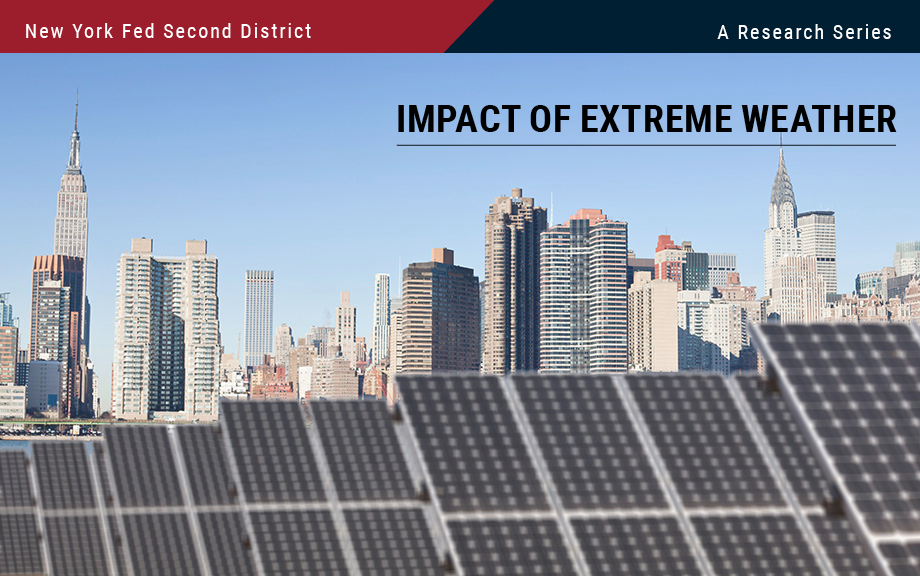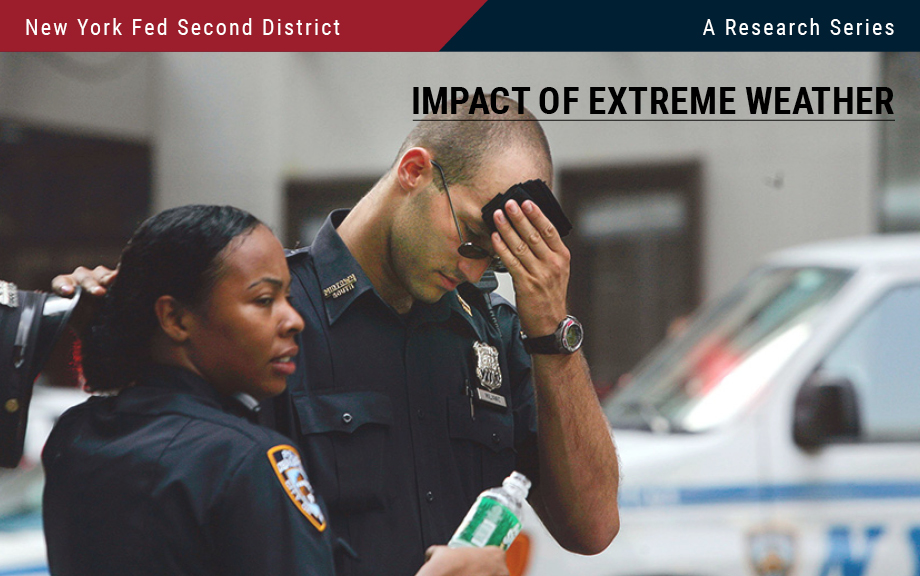Transition Risks in the Fed’s Second District and the Nation

Climate change may pose two types of risk to the economy—from policies and consumer preferences as the energy system transitions to a lower dependence on carbon (in other words, transition risks) or from damages stemming from the direct impacts of climate change (physical risks). In this post, we follow up on our previous post that studied the exposure of the Federal Reserve’s Second District to physical risks by considering how transition risks affect different parts of the District and how they differentially affect the District relative to the nation. We find that, relative to other regions of the U.S., the economy of the Second District has considerably less exposure to fossil fuels. However, the cost of reducing even this relatively low economic dependence on carbon is still likely to be considerable.
Comparing Physical Risk: The Fed’s Second District versus the Nation

In this post, we discuss the climate-related risks faced by the Federal Reserve’s Second District and compare these with risks faced by the nation as a whole. The comparison helps contextualize the risks while framing them in the broader context of a changing climate at the national level. We show that the continental Second District—an area consisting of New York State, the twelve northern-most counties of New Jersey, and Fairfield County in Connecticut—faces fewer and less severe climate-related physical risks than the nation as a whole. However, the areas that comprise the Second District still rank somewhat high in key risks that include “heat stress.” This holds true especially for New York City.
Businesses Want Remote Work, Just Not as Much

The enormous increase in remote work that occurred during the pandemic was a response to a temporary public health crisis. Now that the pandemic has passed, just how much remote work will persist and how much are businesses comfortable with? Results from our August regional business surveys indicate that more than 20 percent of all service work and 4 percent of all manufacturing work is currently being done remotely, nearly identical to what was reported a year ago, and this amount of remote work is expected to persist in the year ahead. However, on average, service sector businesses would prefer that about 15 percent of work be done remotely. Indeed, nearly a quarter of service firms have increased requirements for employees to work on-site over the past year and about one in six plan to make further adjustments toward in-person work next year. Ultimately, the degree and persistence of remote work will largely depend on the tightness of the labor market, as businesses report that while remote work does have its downsides, it has been particularly helpful for attracting and retaining workers.
How Did New York City’s Economy Weather the Pandemic?

When COVID-19 first struck the U.S. in early 2020, New York City was the epicenter of the pandemic. By early April, there was an unthinkable scale of suffering, with massive hospitalizations and roughly 800 fatalities per day, accounting for nearly half of the nationwide total. The rapid spread was facilitated by the city’s extraordinarily high population density and widespread use of mass transit. What followed was a quick and massive shutdown of restaurants, retail stores, personal services, offices, and more. And the shutdowns, of course, led to widespread job losses. Between February and May, one out of five jobs in the city vanished; in the restaurant industry, 70 percent of jobs were lost. Although the pandemic didn’t go away, the city’s economy has recovered steadily, aside from a brief but sharp setback in late 2020. By early 2023, New York had finally reversed just about all of the total job loss. In this post, we look at the contours of the city’s recovery as a possible guide to where we go from here.
The Tri‑State Region’s Recovery from the Pandemic Recession Three Years On

The tri-state region’s economy was hit especially hard by the pandemic, but three years on, is close to recovering the jobs that were lost. Indeed, employment initially fell by 20 percent in New York City as the pandemic took hold, a significantly sharper decline than for the nation as a whole, and the rest of the region experienced similar declines, creating a much larger hole than in other parts of the country. Three years later, the recovery has been uneven: Recent job growth has been particularly strong in New York City, where employment remains just slightly below pre-pandemic levels, and in Northern New Jersey, which has more than recovered all of the jobs lost early in the pandemic. But it has been sluggish in downstate New York outside of New York City, and in upstate New York, and employment across the region has clearly not reached the level implied by pre-pandemic trends. A dearth of available workers remains a significant constraint on growth in the region, particularly in upstate New York, which had already been suffering from a lack of workers well before the pandemic began
A Look at the New York‑Northern New Jersey Region’s Pandemic Housing Boom

Since the start of the pandemic, home prices in the U.S. have increased by an astonishing 40 percent. The New York-Northern New Jersey region saw a similar meteoric rise, as home prices shot up by 30 percent or more almost everywhere—even in upstate New York, where economic growth was sluggish well before the pandemic hit. New York City is the exception, where home price growth was less than half that pace. Indeed, home prices actually declined in Manhattan early in the pandemic, though they have rebounded markedly since. Much of the region’s home price boom can be traced to the rise in remote work, which increased the already strong demand for housing at a time when housing inventories were low and declining. Home price increases have largely outpaced income gains through the pandemic boom, resulting in a reduction in housing affordability in the region. However, with mortgage rates rising, it appears that the region’s housing boom is waning, as it is for the nation as a whole, with prices leveling off, though the inventory of available homes remains historically low.
Remote Work Is Sticking

When the pandemic hit in early 2020, many businesses quickly and significantly expanded opportunities for their employees to work from home, resulting in a large increase in the share of work being done remotely. Now, more than two years later, how much work is being done from home? In this post, we update our analysis from last year on the extent of remote work in the region. As has been found by others, we find that some of the increase in remote work that began early in the pandemic is sticking. According to firms responding to our August regional business surveys, about 20 percent of all service work and 7 percent of manufacturing work is now being conducted remotely, well above shares before the pandemic, and firms expect little change in these shares a year from now. While responses were mixed, slightly more firms indicated that remote working had reduced rather than increased productivity. Interestingly, however, the rise in remote work has not led to widespread reductions in the amount of workspace being utilized by businesses in the region.
Do Businesses in the Region Expect High Inflation to Persist?

As the economy continues to recover from the pandemic, a combination of strong demand, severe supply disruptions, widespread labor shortages, and surging energy prices has contributed to a rapid increase in inflation. Indeed, the inflation rate, as measured by the Consumer Price Index (CPI), has exceeded 8 percent over the past year, the fastest pace of price increase since the early 1980s. If businesses and consumers expect inflation to be high in the future because it is elevated today, they may change their behavior accordingly, which can make inflation even more persistent. In other words, expectations about the path of future inflation can affect how current inflation will actually evolve. In particular, among businesses, expectations about future inflation can shape how they set wages and prices. Our May regional business surveys asked firms what they expected inflation to be one year, three years, and five years from now. Responses indicate that while businesses, like consumers, expect high inflation to continue over the next year, such elevated levels of inflation are not expected to persist over longer time horizons.
The Omicron Wave Stalled Growth and Led to High Absenteeism in the Region

Even before the start of the new year, businesses in the tri-state region were hampered by supply disruptions, rising input costs, and difficulty finding adequate staff. On top of these challenges, the Omicron wave dealt another setback to the regional economy. With infections running high, many businesses were forced to deal with a combination of reduced demand from customers and renewed absenteeism among workers. Indeed, our regional business surveys indicate that economic growth stalled in early 2022 as firms continued to struggle to find workers. Moreover, employee absenteeism was reported to be nearly three times its normal level. While the path of recovery remains highly uncertain, firms generally expect conditions to improve in the months ahead and many are still adding or planning to add staff.
Severe Supply Disruptions Are Impeding Business Activity in the Region

As the economy continues to recover from the pandemic recession, many businesses are struggling to keep up with surging demand amid widespread supply shortages and delays. While a rare phenomenon before the pandemic, supply chain disruptions have become increasingly common, with transportation of goods becoming especially tricky due to myriad issues such as clogged ports and difficulty finding truck drivers. Indeed, such supply disruptions are expected to continue into next year. Our October regional business surveys asked firms to what extent, if any, they are being affected by supply problems and what measures they have taken in response. Difficulty obtaining supplies was nearly universal among survey respondents, affecting about 80 percent of service firms and 95 percent of manufacturers. A large share of businesses in the region have responded to the disruptions by increasing their selling prices and scaling back their operations.










 RSS Feed
RSS Feed Follow Liberty Street Economics
Follow Liberty Street Economics